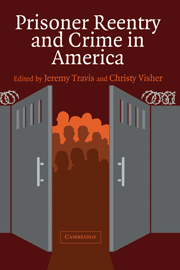Book contents
- Frontmatter
- Contents
- List of Contributors
- 1 INTRODUCTION
- 2 FROM CELL TO SOCIETY
- 3 REENTRY AS A TRANSIENT STATE BETWEEN LIBERTY AND RECOMMITMENT
- 4 THE CONTRIBUTION OF EX-PRISONERS TO CRIME RATES
- 5 DOES SUPERVISION MATTER?
- 6 THE IMPACT OF IMPRISONMENT ON THE DESISTANCE PROCESS
- 7 COMMUNITIES AND REENTRY
- 8 WORK AND FAMILY PERSPECTIVES ON REENTRY
- 9 CONSIDERING THE POLICY IMPLICATIONS
- Index
7 - COMMUNITIES AND REENTRY
CONCENTRATED REENTRY CYCLING
Published online by Cambridge University Press: 05 June 2012
- Frontmatter
- Contents
- List of Contributors
- 1 INTRODUCTION
- 2 FROM CELL TO SOCIETY
- 3 REENTRY AS A TRANSIENT STATE BETWEEN LIBERTY AND RECOMMITMENT
- 4 THE CONTRIBUTION OF EX-PRISONERS TO CRIME RATES
- 5 DOES SUPERVISION MATTER?
- 6 THE IMPACT OF IMPRISONMENT ON THE DESISTANCE PROCESS
- 7 COMMUNITIES AND REENTRY
- 8 WORK AND FAMILY PERSPECTIVES ON REENTRY
- 9 CONSIDERING THE POLICY IMPLICATIONS
- Index
Summary
It is easy to view reentry through the lens of the individuals who are personally involved. Coming home from prison, as Joan Petersilia (2003) has termed it, is an intense personal experience. To come home is to rejoin the lives of families, associates, and other intimates. The personal issues that arise for the ex-prisoner coming home pose weighty challenges for the individual and his or her close associates, and it is not difficult to see why they matter. A growing literature now examines the significance of reentry for the individuals who experience it.
Yet the focus of this chapter is reentry as a community (rather than an individual) phenomenon. It is less obvious how reentry manifests itself at the community level, although its impact on communities is worthy of special attention. Reentry, because it is highly stigmatizing as well as concentrated among people already troubled by poverty and exclusion, can be a significant factor of community life – one that transcends the sum of individual experiences. We also consider the effects of incarceration. Incarceration sets the stage for reentry, affecting the same communities that reentry does and thereby compounding the effects of reentry in poor communities that have high rates of residents cycling in and out of prison. We have referred to these intertwined processes as “reentry cycling” and their impact on the community as “coercive mobility” (Clear, Rose, Waring, and Scully 2003).
- Type
- Chapter
- Information
- Prisoner Reentry and Crime in America , pp. 179 - 208Publisher: Cambridge University PressPrint publication year: 2005
- 26
- Cited by

